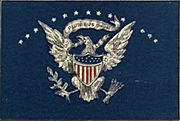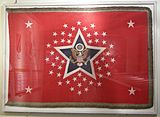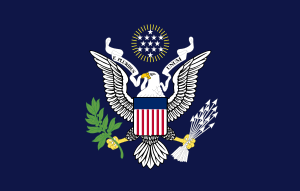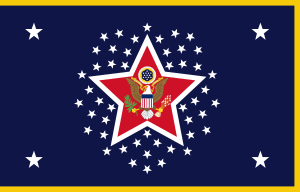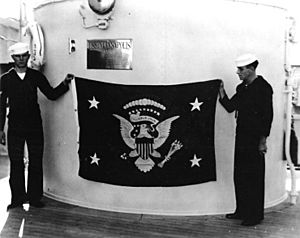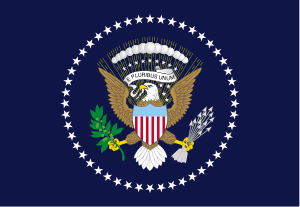Flag of the president of the United States facts for kids
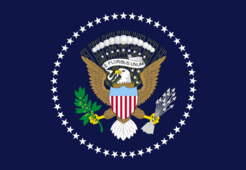
Current flag of the president of the United States (since 1960).
|
|
| Use | |
|---|---|
| Proportion | Varies with military and naval custom |
| Adopted | 1945, 50-star version in 1960 |
| Design | Dark blue background with the presidential seal in the center |
| Designed by | George Elsey, Arthur DuBois |
The flag of the president of the United States is dark blue with the presidential seal in the middle. This flag has been used since 1945, but its design has changed over time. The flag is often seen when the president is in official photos or during important events. It is also flown next to the casket of a former president during funerals. Unlike some other countries, the U.S. presidential flag does not replace the national flag at the White House. The American flag always flies over the White House, whether the president is there or not.
Contents
How the Presidential Flag Started
For a long time, there wasn't a special flag just for the U.S. president. People sometimes suggested ideas for one. For example, in 1817, a flag was proposed with four different sections, but it was never adopted.
Sometimes, special flags were used for presidents on certain trips. For instance, there are stories of a blue flag being used for President Martin Van Buren in 1839 when he was on a boat.
Some old books from the 1840s and 1850s show a flag they called the U.S. president's flag. It looked like the Great Seal, which is a common symbol for leaders. However, official records don't mention this flag.
Since the president is the leader of the Army and Navy, these military branches eventually created their own ways to honor the president. This led to them designing their own presidential flags much later. Before that, the Navy used existing flags. For example, they sometimes flew the union jack (the blue part of the national flag with stars) to show the president was on board a ship.
In 1882, President Chester Arthur noticed that many other countries had special flags for their leaders, but the U.S. president did not. He decided it was time for one. On August 9, 1882, the Navy created the first official presidential flag. It was a blue flag with the United States coat of arms in the center.
This first Navy flag showed an eagle with bent legs, similar to how the Great Seal looked at that time. Instead of clouds, there was an arc of thirteen stars above the eagle. The eagle, arrows, and olive branch were all white.
President Arthur first used this flag in 1883 during a trip to Florida. It was mostly used on boats, like the presidential yacht USS Dolphin. Later, around 1897, the design on the flag was updated to match the official Great Seal, and it was shown in full color. The Navy used this design until 1916.
The Army's Presidential Flag (1898)
In 1898, the Army decided it also needed its own flag for the president, who is their Commander-in-Chief. The Navy's flag was too similar to the Army's infantry flag. So, a new design was created.
This Army flag was officially adopted on March 28, 1898. It was scarlet (red) with a large blue star in the middle. Inside the blue star was the Great Seal. There were also four white stars in the corners and 45 small white stars scattered around, representing the 45 states at the time. This flag was used in the White House and shown publicly during celebrations in 1898.
When Oklahoma became a state in 1908, a 46th star was added to the Army flag.
The 1902 Flag and Later Changes
Having two different flags for the president (one for the Navy and one for the Army) caused some confusion. In 1901, President Theodore Roosevelt decided there should only be one official flag for the president. He chose the Navy's version because it was older.
However, a third flag was introduced in May 1902. This flag also had the Great Seal on a blue background, like the Navy flag. But the eagle and other parts were shown in pure white with black outlines. This flag was supposedly for peacetime use, while the original two flags were for wartime. Photos show this 1902 design was indeed used, for example, on the presidential yacht Mayflower in 1912.
1912 Army Color Update
In 1912, President William Taft wanted to simplify things. He issued an order that stated the president's flag should always have a blue background. This meant the Army's red flag had to change. So, in 1913, the Army's presidential flag (called a "color" for ceremonial use) also became blue, with a scarlet star in the middle. It was updated to have 48 stars, matching the number of states at the time.
The 1916 Presidential Flag
In 1915, President Woodrow Wilson saw both the presidential flag and the Army's presidential color displayed together. This led to more discussions about having just one flag. An idea was suggested to add four white stars to the corners of the Navy flag. President Wilson liked this idea, but he wanted the eagle on the flag to be the one from the presidential seal, which faced left.
On May 29, 1916, President Wilson officially changed the flag's design. The eagle was mostly white with black outlines, and its beak and feet were yellow. The flag also had four large stars, one in each corner. This new design was used by both the Army and Navy, finally creating one official presidential flag that lasted until 1945.
The Current Presidential Flag (1945-Present)
The flag was changed again in 1945 by President Harry S. Truman. This change was actually started by President Franklin D. Roosevelt before he passed away. The main change was that the eagle on the flag was updated to face its right (which is considered the direction of honor) and towards the olive branch. The eagle was also shown in full color. Instead of four stars in the corners, a circle of 48 stars was added around the eagle, representing the 48 states.
President Truman made this new design official on October 25, 1945. The flag was first flown two days later. Since then, the only changes have been to add more stars as new states joined the United States. President Dwight D. Eisenhower added a star for Alaska in 1959 and another for Hawaii in 1960. The flag's design has remained the same since then.
The current flag is dark blue. It has the Coat of Arms of the President in the center with its proper colors. The size of the flag and its parts can change slightly to fit military and naval traditions.
The official rules for the flag also describe the exact colors:
- Flag background: blue
- Stars: white
- Shield: light blue at the top, with white and red stripes below
- Eagle: shades of brown for the body, white and gray for the head and tail, yellow for the beak and feet
- Arrows: white with gray shading
- Olive branch: green leaves, light green olives
- Rays (behind the eagle): yellow
- Clouds: white with gray shading
- Scroll (with the motto): white with gray shadows
- Letters (on the scroll): black
The design appears on both sides of the flag.
Rules for Reproducing the Flag
It is against the law to copy or sell the flag of the president. This is because it looks very much like the official seal of the president, which is protected by law.
Images for kids
Edward C. Kuhn, who designed many early U.S. Army symbols, made watercolor paintings of older presidential flags.
See also
 In Spanish: Bandera del presidente de los Estados Unidos para niños
In Spanish: Bandera del presidente de los Estados Unidos para niños
- Flag of the vice president of the United States
- Flags of governors of the U.S. states
- Great Seal of the United States
- Seal of the president of the United States



